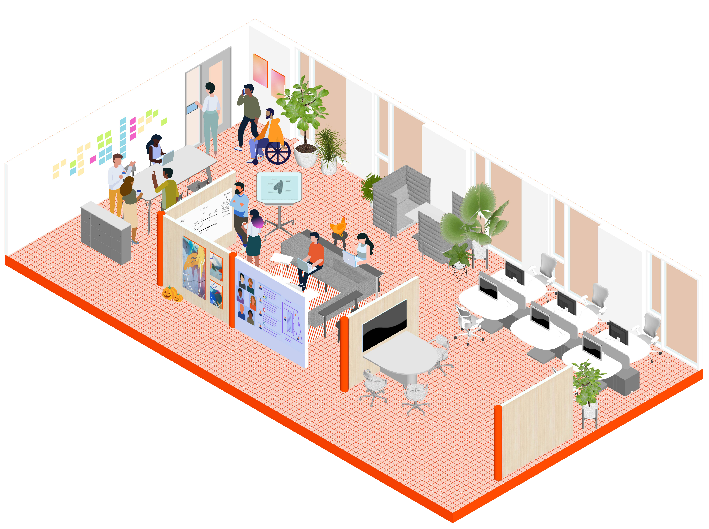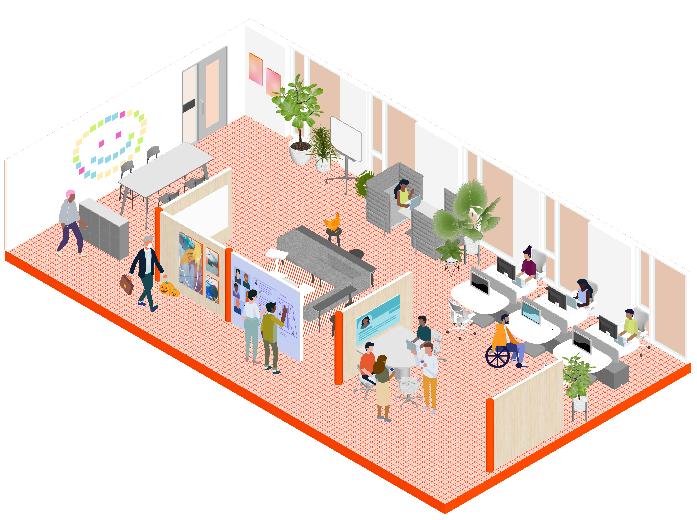Due to pandemic lockdowns and quarantines, the whole world has been thrown into a year-long, work-from-home experiment—a trend that struggled to gain a foothold prior to COVID-19.
Only one in five workers say they worked from home all or most of the time pre-pandemic, according to a new Pew Research Center survey. Now, in an astonishing shift, 71 percent say they’re doing their job from home all or most of the time.
Across the United States, people were forced to vacate their offices last March and find ways to work remotely. What’s clear is that not all home work setups are created equal. While it may be going smoothly for those with dedicated workspaces, gigabit Internet and ergonomic office furniture, others struggle working at kitchen tables with spotty Wi-Fi and distracting roommates.
“I think it was very telling early on that, when we turned on our cameras for video conferencing, you immediately could tell people were in different work-from-home situations,” notes Hao Ko, principal and managing director at architecture and design firm Gensler.
Despite their technical proficiency, millennials and Gen Zers are having the most difficulty working from home during the pandemic. With no office to go to, they may struggle with unsuitable home workspaces and are missing opportunities to grow their networks as they look to climb the corporate ladder. They also miss socializing with colleagues. Millennials may be juggling working at home with raising young children. Then there are employees who can’t afford reliable Internet access and necessary equipment to do their jobs.
These circumstances prompt tenant companies to reexamine the importance of an equitable work environment both now and in the post-pandemic future. And, property professionals should be prepared to support these efforts every step of the way.
Employees want to return to the office—at least part time
According to the groundbreaking BOMA International Commercial Real Estate COVID-19 Impact Study, 61 percent of office space decision-makers across all segments plan on some reassessment of their space needs because of the pandemic. And, 25 percent of respondents shared that they’re already considering the implementation of hoteling or flexible work desks to accommodate a more hybrid workplace model that would involve employees splitting time between the office and home.
Whatever those space reassessments ultimately include, they will need to consider the 88 percent of Gensler U.S. Work from Home Survey respondents who indicated they want to return to the office in some capacity. Not only do employees miss interactions with coworkers and likely suffer from so-called “Zoom fatigue,” they feel they can be more productive at the office due to the extreme differences in remote work setups.
Some experts, however, worry that working remotely (even part-time) might threaten the workplace equity that traditional offices have always provided employees. In many ways, the office is the equalizer as people have equal access to the tools they need to succeed, says Lisa Cholmondeley, principal and architect at Gensler.
“What was good about the office—and will be again in the future—is it offered a common ground for everyone,” Cholmondeley explains. “It didn’t matter where you came from, what your home situation was. When you came to this place, you often had the same desk, the same Wi-Fi, the same tools, the same software. It was a more even playing field.”
Now, as more companies move to a hybrid model and slowly welcome employees back to the in-person workplace, the challenge is whether they can do so in a way that creates an equitable work environment for all.
“The question is, how do we maintain that equity of tools so that everyone has the same kind of chance to have their talents grow—whether they’re at home or in the office?” Cholmondeley asks. “How do you make sure that the people who are remote and on the screen in the meeting have the same access and opportunities as those in the office?” One way is making employees feel supported.
During this hybrid time of transition, firms may need to find ways to expand the principles of office equity to employees’ homes by investing in technology and resources to improve work-from-home environments, including better Wi-Fi, office furniture and monitors. Some companies are offering employees stipends to purchase office equipment and furniture while others are loaning items out.
“What was good about the office—and will be again in the future—is it offered a common ground for everyone.”
Office space connects people
While the office provides essential tools to work, it also provides valuable access to people. Many opportunities exist across departments to attend meetings, after-hour social networking, impromptu get-togethers and engagements with senior management.
“When going to the office, not only does it equalize in the sense of the access you have to certain resources, it also just adds that social aspect we as humans desire and need in some capacity,” says Kamillah Knight, co-founder of Éclat Culture LLC, which offers coaching and consulting services to organizations around diversity and inclusion.
Knight also says the office is about experiences.
“When you’re in the office, you might walk up and have a conversation with someone at the water cooler or in the cafeteria,” Knight continues. “There’s a whole level of experience that I think is missing that you can’t really mimic via Zoom or Microsoft Teams.”
While the physical office matters in many ways, Knight also says there are new opportunities that have come out of this virtual environment. For example, companies invest significantly in in-person training, often with a cap on how many employees can participate.
“It’s probably only your senior employees who traditionally have been invited,” Knight says. “But now with everything being virtual, you can have hundreds of people sign on to this call, so it’s saving companies money in that capacity and making sure that they’re actually reaching more employees. I do think there are some cool things that I’m sure companies will continue to utilize once we’re back in the office, like hosting these virtual trainings.”
The office also offers the ability to make spontaneous connections with people of different backgrounds, ages, zip codes and lifestyles, which can support equity, according to Gensler.
As awareness around issues of diversity and inclusion grows, more emphasis can be placed on learning about and respecting different cultures, backgrounds and lifestyles. The post-pandemic office can be a tool to reconnect people in new ways.
“When going to the office, not only does it equalize in the sense of the access you have to certain resources, it also just adds that social aspect we as humans desire and need in some capacity.”
What’s in store for future offices?
While no one knows for sure what the future office will look like, Gensler believes it will be a place where people meet, socialize and work with each other. It will shift from a “work” place for individual work to a “convening” place for group work. Offices will build community, reinforce culture and strengthen relationships. Companies might split the work week with employees working at home for heads-down work and virtual collaborative meetings and coming into the office to work with teams and meet clients in person.
“I think the purpose of going into the office will be for more community,” Ko explains. When you look at surveys, he says, the reason people want to go back to the office is to interact with others. This notion is also supported by BOMA's COVID-19 Impact Study findings, which show commercial office decision-makers and high-level influencers continue to see and forecast significant value in on-site business operations, particularly as it relates to collaboration, coaching and culture.
“If it’s all about community, then the office will need to adapt and have more spaces where people can gather versus just having more individual desks,” Ko explains. “We also need more technology that can help support that interaction and make that experience of interacting just as robust for someone who’s remote as it is for someone who’s in-person.”
Cholmondeley envisions more places to stand and work, lounge seating and small collaboration meeting spaces.


Pictured above: Renderings provided by Gensler display how open office space may be utilized in the future.
Challenges with hybrid model
Despite its success during COVID-19, history proves that mixing virtual and in-office work might be tougher in the long term.
“When people start coming back to work, it’s going to be harder than people realize,” says Rachel Casanova, Cushman & Wakefield’s senior managing director of Workplace Innovation.
Pre-pandemic, Casanova says, people weren’t in the office all the time, as they were traveling, meeting clients or visiting other corporate locations. But then the dial was turned 180 degrees, and depending on the industry, everyone began working at home.
“Hybrid is not a third fit; it’s everything in between those bookends,” Casanova explains. “Everyone has to define their version, and it’s going to require an investment in people, process and technology. You’re going to have to manage people and work differently. This is going to be so much more complex than, ‘Oh, instead of being anchored at your desk, you’re anchored at home.’”
But place matters—and office matters—and companies will try and work to figure it out, Casanova notes.
“The office provides a place to build purpose and community, and we know it’s still invaluable within the ecosystem of a company,” she explains.
When people return, it will be a whole system mindset from an HR and leadership perspective on how to manage process and performance.
“Only when we figure out the business changes—the processes, the technologies, the products we’re selling—and how they will continue to evolve, will we know what the long-term future of the office should be,” Casanova adds. (Check out BOMA’s Charting a Path to the Future of Office for more on the path to Workplace 2.0.)
The office provides a place to build purpose and community, and we know it's still invaluable within the ecosystem of a company."
No going backwards
There’s opportunity to rethink how people will go about working when they return. Some of these trends were already in progress, but COVID-19 has fast-tracked them.
Ko worries that, when we return to some sense of normalcy, it will be easy to default to how companies worked before the pandemic, which in some cases was with less consideration toward equity issues.
“It would be a shame to let this window for change go to waste,” Ko points out. “Hopefully, the immediate health crisis will pass, and lead to a better way of working; something that’s more innovative and inspiring and leads to more incredible spaces.”
ABOUT THE AUTHOR: Liz Wolf is a Twin Cities-based freelance writer with 30-plus years of business and commercial real estate reporting experience. She previously served as editor of the Minnesota Real Estate Journal.